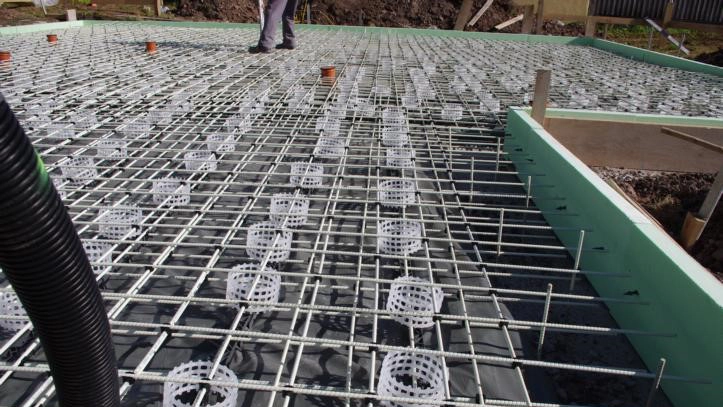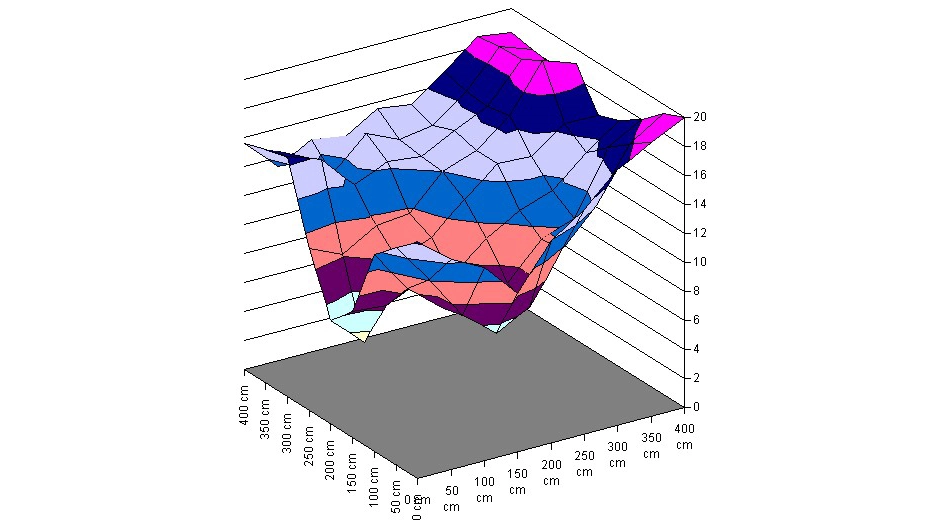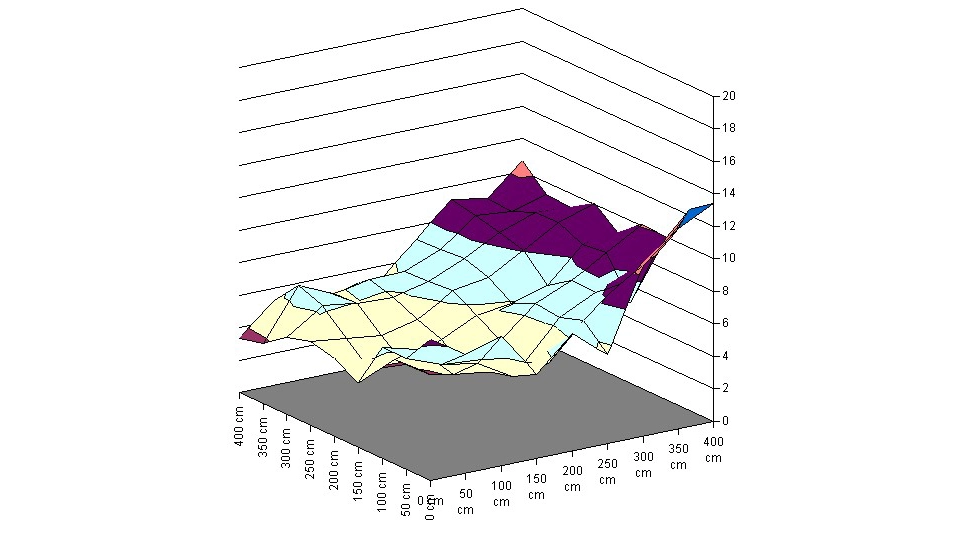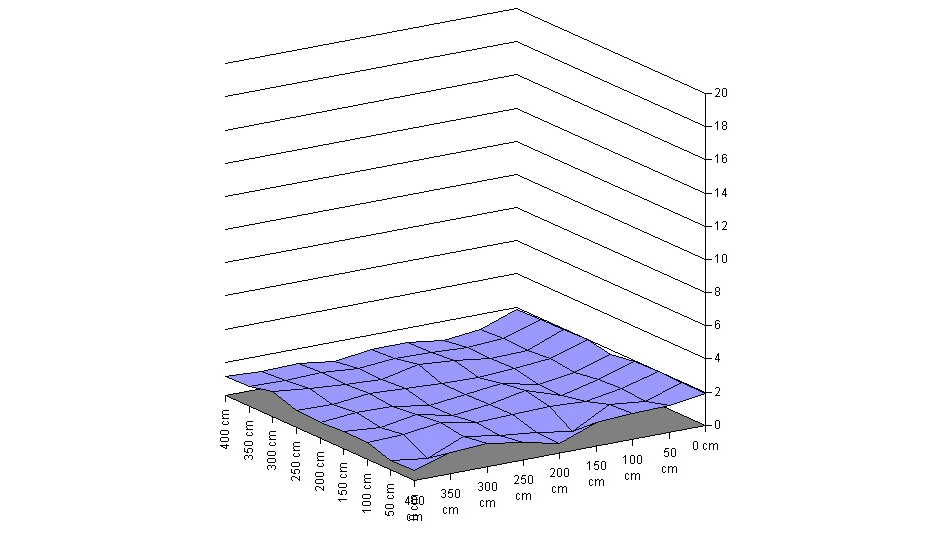Metal-free reinforced concrete
Informed clients
Informed and health-conscious clients are increasingly asking questions about the distortion of the Earth’s magnetic field with regard to building materials. Besides the home as a whole, the areas of relaxation and regeneration, such as bedrooms, are of particular concern. Another question concerns the possibility of stray currents that could be caused by metal connections (e.g. metal gas and water pipes), steel reinforcement in the ground floor slab, and the ground ring electrode of the building.
The Institute of Building Biology (IBN), Germany, demands in its 25 Principles of Building Biology that the natural Earth’s magnetic field should not be distorted.
Distortion of the Earth’s magnetic field
Distortions of the Earth’s magnetic field are caused by metallic objects in a building. They can be divided into two different categories: (a) furnishings and appliances and (b) building products and materials.
Category A includes furnishings and appliances. These are mainly larger appliances such as washing machines, dryers, radiators, and steel bathtubs. Cars parked in garages next to or inside the house are also included. These sources are accessible to informed users because they are visible and their location can be changed. Smaller metal parts can be found in innerspring mattresses, which are rather close to the body, especially during sleep.
Category B includes all the invisible sources such as building products and materials made of steel that are installed in foundations, floor slabs, ring beams, joists, and window and door lintels. Because these steel components are permanently installed in floors, walls, or ceilings and then hidden by other building materials, occupants are generally unaware of these sources.
Foundations and floor slabs are the most critical areas in a building due to the large amount of material and the large installation area.
Alternatives to steel-reinforced concrete include:
- Ground floor slab: fiber-reinforced concrete or fiberglass rebar Schöck ComBAR®.
- Floor slab: solid timber joists or fiberglass rebar Schöck ComBAR®
In the case of brick ceilings, steel components are not spread out over a large area, but are limited to localized areas as supports for the brick elements to be suspended.
Our investigation
Wood frame houses are built either on a steel-reinforced ground floor slab or on a basement with a steel-reinforced floor slab. As an alternative, fiberglass reinforcement can be used.
For this investigation, we took measurements of static magnetic fields in two different building projects. One house was built with a conventional steel-reinforced ground floor slab. And in the other house, the steel reinforcement was replaced by ComBAR fiberglass reinforcement.
Reinforcing welded wire mesh made of steel is manufactured in the factory, has standardized dimensions (e.g. 6 x 2.4 m), and is installed on site over a large area with an overlap. For smaller areas, the appropriate size is cut out of the pre-fabricated mesh.
Fiberglass rebar is custom-made by the manufacturer to the dimensions of a particular house (e.g. 8 m long and 6 m wide). These fiberglass rebars are joined together on site with special clips to form a grid pattern as specified by the manufacturer.

Steel reinforcement prior to pouring concrete
Fiberglass reinforcement prior to pouring concrete1 Steel reinforcement prior to pouring concrete
2 Fiberglass reinforcement prior to pouring concrete
In both projects, a 4 x 4 m (13 x 13 ft) area was used for measurements in one corner of the building after the floor slab was completed. During the measurements, care was taken to ensure that there were no other metallic objects – such as construction supports, cranes, or scaffolding – within a radius of at least 5 m (16 ft) that could interfere with the results. Measurements were taken at heights of 55 cm (22 in) and 105 cm (41 in) above the floor slab. The height of 55 cm (22 in) corresponds approximately to the mattress level of a bed (15 cm / 6 in floor assembly + 40 cm / 16 in bed). This is the area where we spend several hours to rest and regenerate. To determine whether the influence of the steel or fiberglass reinforcement changes with distance, the second height was set at 105 cm (41 in).
The measurement points were defined in a grid of 50 x 50 cm (20 x 20 in) over an area of 4 x 4 m (13 x 13 ft), corresponding to 81 measurement points. The probe was placed in a plastic holder, which in turn was attached vertically to a two-by-four. In this way, distortions of the Earth’s magnetic field caused by the instrument could be excluded.
The length of the probe was aligned parallel to one edge of the ground floor slab and moved parallel to it for all further measurements. The data of the three axes x, y, and z were recorded for each measurement point. These values were the actual magnetic flux densities of the Earth’s magnetic field.
To improve the presentation of the results, the values were normalized to the highest value on each axis. This was set to 0 and the deviations of the other measurements were recorded in relation to it. This means that all values are positive and therefore the values and graphs are directly comparable to each other. When calculating the RMS value, the result is not 0, because the three „zero points“ of the individual axes are not at the same measurement point.
Measurement results
The measurement results for the steel-reinforced concrete slab show that the magnetic flux densities within a defined area deviate from the Earth’s magnetic field by up to 20 µT (microtesla) at a height of 55 cm (22 in) and by up to 10 µT at a height of 105 cm (41 in). It should be noted that the natural Earth’s magnetic field in Central Europe is approximately 50 µT. According to the Building Biology Evaluation Guidelines for Sleeping Areas (SBM-2008) by the Institute of Building Biology IBN, deviations between 5 µT and 20 µT are classified as a „strong anomaly“ and deviations above 20 µT as an „extreme anomaly.“
The measurement results for the Schöck ComBAR fiberglass-reinforced concrete slab show no changes in the natural Earth’s magnetic field. The results show very clearly that by using fiberglass reinforcement, it is possible to avoid extra stress and distortions of the Earth’s magnetic field associated with steel reinforcement.
Due to the fact that the measuring instrument was not exactly aligned, there were slight fluctuations, which also reflect the tolerance of such a measurement setup.
For better comparability, all graphs are shown with the same resolution (2 µT and max. 20 µT) and the RMS values.

Magnetic flux density at a height of 55 cm (22 in) above a steel-reinforced ground floor slab
Magnetic flux density at a height of 105 cm (41 in) above a steel-reinforced ground floor slab
Magnetic flux density at a height of 55 cm (22 in) above a fiberglass-reinforced ground floor slab3 Magnetic flux density at a height of 55 cm (22 in) above a steel-reinforced ground floor slab
4 Magnetic flux density at a height of 105 cm (41 in) above a steel-reinforced ground floor slab
5 Magnetic flux density at a height of 55 cm (22 in) above a fiberglass-reinforced ground floor slab
Summary
The measurement results show very clearly that by using fiberglass reinforcement, it is possible to avoid extra stress and distortions of the Earth’s magnetic field associated with steel reinforcement. Fiberglass rebar in combination with concrete can be used to install ground floor slabs and floor slabs, ring beams and lintels, as well as girders and other structural supports.
Fiberglass reinforcement products: *)
Europe
- Schoeck: Combar (Germany)
- Solidian Keltkeks: solidian REBAR, mateenbar (Germany, Turkey, Croatia)
North America
- MST Rebar: MST-BAR (Canada, USA, Australia)
- RJD Industries: Aslan 100 (USA)
- Owens Corning + Pultron Composite: mateenbar (USA)
Many manufacturers ship worldwide
*) As an independent institute, we don’t usually publish any specific products or companies. But in this case, we’re making an exception because there are only a few manufacturers in this product category.
This is a translation of „Metallfreie Armierung“, Magazine „Wohnung + Gesundheit“ Nr. 143/2012.
Translator
Katharina Gustavs is a Building Biology Professional in Victoria, Canada, who translated the Building Biology Online Course IBN.
info@katharinaconsulting.com | katharinaconsulting.com
Ihre Stimme zählt
Kommentarregeln:
Wir sind neugierig, was Sie zu sagen haben. Hier ist Raum für Ihre Meinung, Erfahrung, Stellungnahme oder ergänzende Informationen. Bitte beachten Sie bei Ihrem Kommentar folgende Regeln:
- Bitte keine Fragen: Auf dieser kostenlosen Informationsplattform können wir keine Fragen beantworten - bitte stellen Sie Ihre Fragen direkt an unsere Autor*innenAutor*innen.
- Bitte keine Werbung: Gerne können Sie auf Ihre Produkte/Dienstleistungen mit einem Werbebanner aufmerksam machen.

Wie werde ich
Baubiolog*in IBN?

How to become a Building Biology Consultant IBN?
Nachhaltig weiterbilden
Know-how, Zusatzqualifikationen und neue berufliche Möglichkeiten für Baufachleute sowie alle, die sich für gesundes, nachhaltiges Bauen und Wohnen interessieren.
Unser Kompetenz-Netzwerk
Hier finden Sie unsere qualifizierten Baubiologischen Beratungsstellen und Kontakte im In- und Ausland nach Standort und Themen sortiert.
Über die Baubiologie
Die Baubiologie beschäftigt sich mit der Beziehung zwischen Menschen und ihrer gebauten Umwelt. Wie wirken sich Gebäude, Baustoffe und Architektur auf Mensch und Natur aus? Dabei werden ganzheitlich gesundheitliche, nachhaltige und gestalterische Aspekte betrachtet.
25 Leitlinien
Für einen schnellen, aufschlussreichen Überblick haben wir in 25 Leitlinien der Baubiologie die wichtigsten Parameter herausgearbeitet, sortiert und zusammengefasst. In 15 Sprachen, als PDF oder als Plakat erhältlich.


0 Kommentare